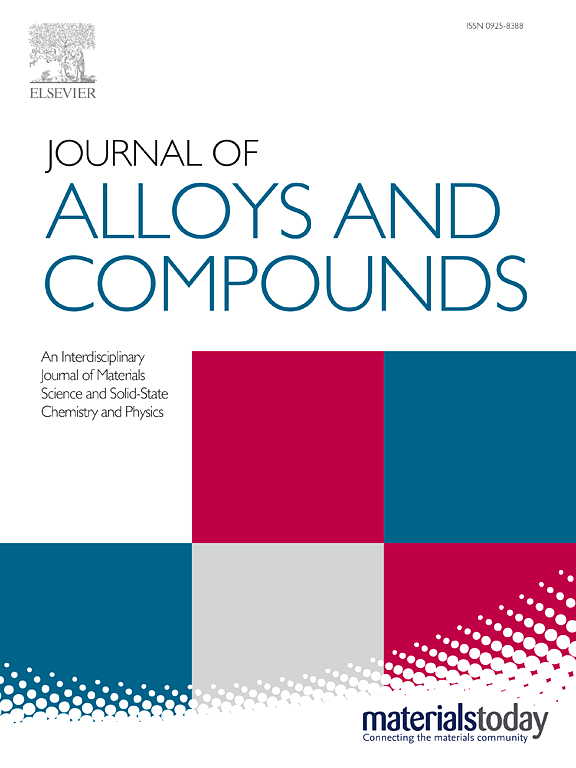Experimental investigation on the role of Bi³⁺ composition in structural, elastic, and radiation shielding properties of multifunctional cobalt-nickel nanoferrites
IF 5.8
2区 材料科学
Q2 CHEMISTRY, PHYSICAL
引用次数: 0
Abstract
The growing demand for effective radiation shielding materials has led to the exploration of alternative options to conventional materials, such as lead (Pb), which are heavy, toxic, and expensive. In this study, bismuth-doped nickel cobalt nanoferrites (Ni0.5Co0.5BixFe2-xO4, with x = 00, 0.05, 0.10, 0.15, and 0.2 %) were synthesised via the solution combustion method. The effect of Bi composition in XRD analysis revealed a single-phase cubic spinel structure for low Bi compositions (x ≤ 0.05) and a dual-phase structure with α-Bi₂O₃ at higher doping levels (x ≥ 0.1). FTIR spectroscopy identified vibrational modes and band shifts attributed to lattice strain induced by Bi doping. The elastic properties, such as bulk modulus (B), rigidity modulus (G), Young’s modulus (Y), and Poisson’s ratio (σ) of the developed nanoferrites were studied with varying Bi composition. Young’s modulus showed a gradual variation between 195.26 GPa to 191.39 GPa, further supporting the idea of reduced elastic stiffness with increasing Bi composition. Additionally, the radiation shielding performance of these nanoferrites was experimentally evaluated using a NaI(Tl) detector and gamma sources (133Ba, 137Cs, 22Na, and 60Co). The mass attenuation coefficients, linear attenuation coefficients, half-value layer, tenth-value layer, mean free path, effective atomic number, and fast neutron removal cross-sections were computed using Phy-X/PSD software for various gamma energies. Experimental mass attenuation coefficients of nanoferrites (NCBFO-00 to NCBFO-0.20) increased from 0.0759 to 0.0797 cm2/g at 0.662 MeV. Among all the samples, the highest Bi-doped nanoferrites (NCBFO-0.20) demonstrated superior radiation shielding performance, making it a promising candidate for radiation protection applications.
Bi +组成对多功能钴镍纳米铁氧体结构、弹性和辐射屏蔽性能影响的实验研究
对有效辐射屏蔽材料的需求不断增长,导致人们探索替代传统材料的选择,如铅(Pb),这种材料重、有毒且昂贵。本研究通过溶液燃烧法合成了掺杂铋的镍钴纳米铁素体(Ni0.5Co0.5BixFe2-xO4, x=00, 0.05, 0.10, 0.15, 0.2%)。XRD分析表明,低Bi成分(x≤0.05)为单相立方尖晶石结构,高Bi含量(x≥0.1)为含α-Bi₂O₃的双相结构。傅里叶红外光谱分析发现了铋掺杂引起的晶格应变引起的振动模式和带移。研究了不同铋组分下制备的纳米铁素体的体积模量(B)、刚度模量(G)、杨氏模量(Y)和泊松比(σ)等弹性性能。杨氏模量在195.26 GPa到191.39 GPa之间逐渐变化,进一步支持了Bi成分增加导致弹性刚度降低的观点。此外,利用NaI(Tl)探测器和γ源(133Ba, 137Cs, 22Na和60Co)实验评估了这些纳米铁氧体的辐射屏蔽性能。利用Phy-X/PSD软件计算不同γ能量下的质量衰减系数、线性衰减系数、半值层、十值层、平均自由程、有效原子序数和快中子去除截面。在0.662 MeV下,纳米铁素体(NCBFO-00 ~ NCBFO-0.20)的实验质量衰减系数从0.0759增加到0.0797 cm2/g。在所有样品中,双掺杂最高的纳米铁氧体(NCBFO-0.20)表现出优异的辐射屏蔽性能,使其成为辐射防护应用的有希望的候选者。
本文章由计算机程序翻译,如有差异,请以英文原文为准。
求助全文
约1分钟内获得全文
求助全文
来源期刊

Journal of Alloys and Compounds
工程技术-材料科学:综合
CiteScore
11.10
自引率
14.50%
发文量
5146
审稿时长
67 days
期刊介绍:
The Journal of Alloys and Compounds is intended to serve as an international medium for the publication of work on solid materials comprising compounds as well as alloys. Its great strength lies in the diversity of discipline which it encompasses, drawing together results from materials science, solid-state chemistry and physics.
 求助内容:
求助内容: 应助结果提醒方式:
应助结果提醒方式:


